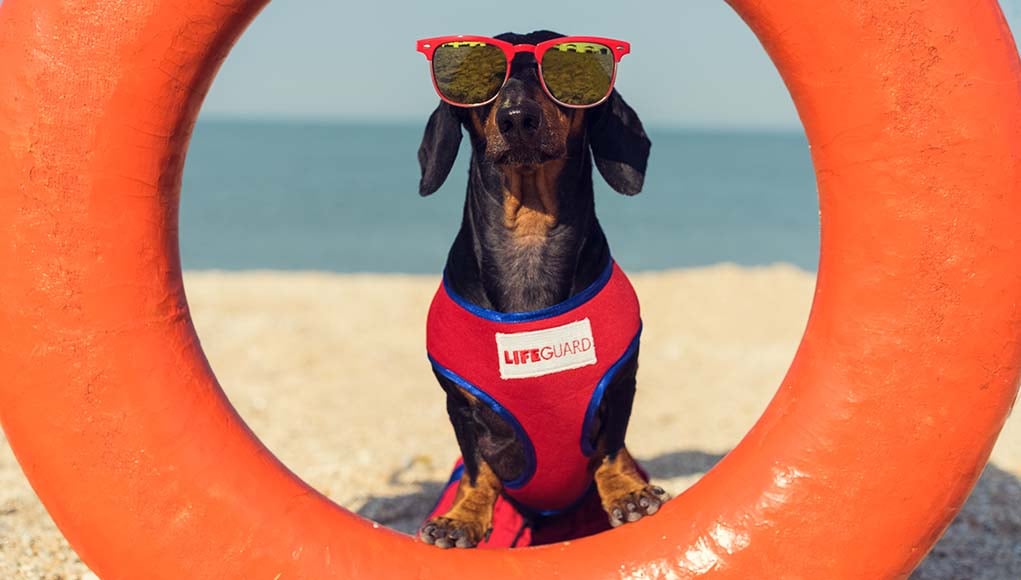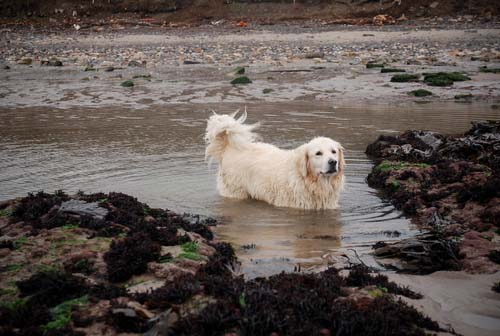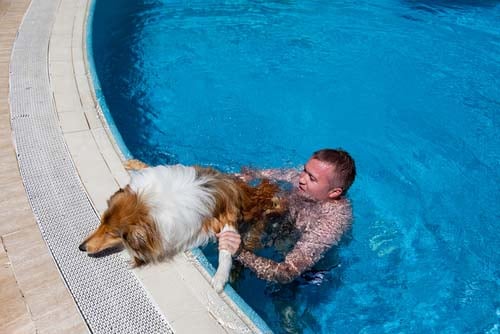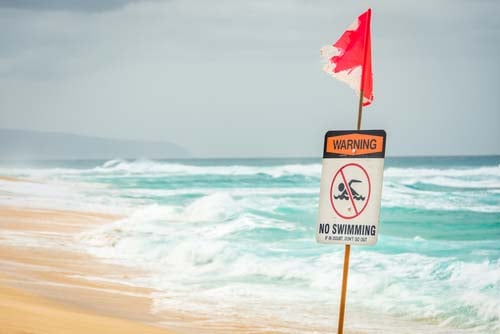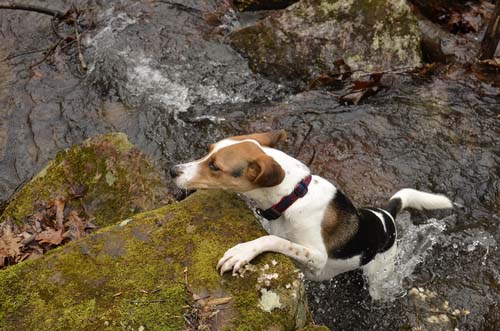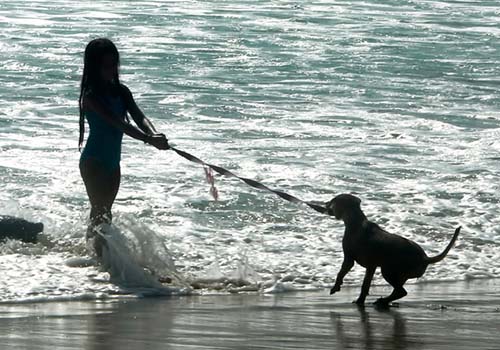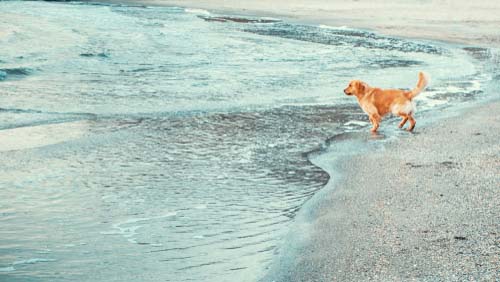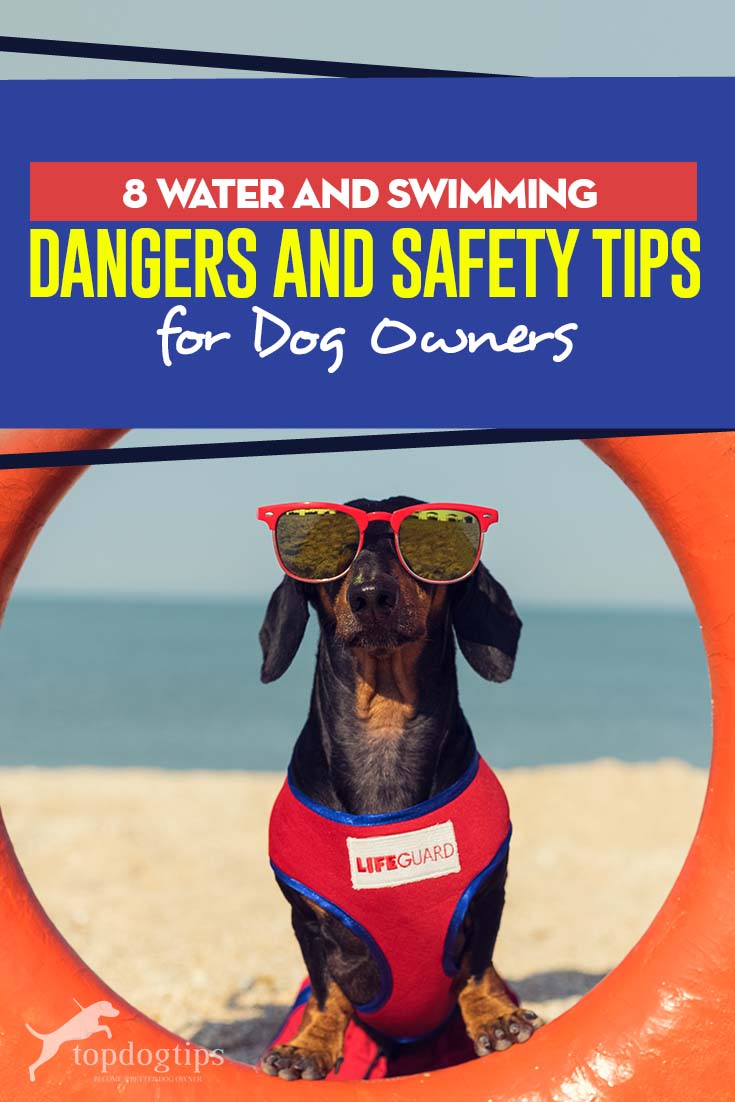Summer swimming with your dogs is one of the many perks of being a pet parent. What could be better than going to the lake with your pup in tow or even opening up your backyard pool and lazing in the cool water while your dog chases pool noodles? As you prepare to head to the lake or the pool in the coming months, please don’t forget about water safety too.
Water Safety Isn’t Just About Your Dog
When we talk about water safety and your dog swimming, the emphasis seems to be keeping your pup safe, but it’s also about keeping everyone else safe too. For example, if you’re like most protective dog parents, when you see your pup in trouble in the water, your first instinct is going to be to jump in and save them.
Now, if you’ve ever seen your dog panic in the water then you’ll know that their instinct is almost always to grab onto you with their front paws amid flailing. This poses a problem for you because now you’re trying to keep yourself and your dog afloat while being clawed to death, smacked with flailing paws, and trying to get back to dry land. If there are other people around, they too are in danger of being “grabbed” or in the very least smacked by flailing limbs.
So, yes, while water and dog swimming safety tips are primarily about keeping your pooch safe, they are also about keeping yourself and everyone around safe as well.
What do I mean by “water safety”?
When referencing “water safety” we are generally talking about anything having to do with being in or near water. Technically, water safety can also include bathtub safety, but for the purpose of our discussion, we will be talking about your regular backyard pools, your special dog swimming pools, as well as lakes, rivers, seas and oceans (although the concepts may apply to any other bodies of water as well).
ALSO READ: 20 Dog Breeds Worst at Swimming
Water and Dog Swimming Safety Tips
1. Don’t Assume That Your Dog Knows How to Swim or is a Good Swimmer
Not all dogs can or will swim when put in water. Most dogs instinctively paddle their legs in the characteristic “doggy paddle”, but some dogs and even certain dog breeds – particularly those that weren’t developed with swimming in mind – don’t know how to swim well, and may or may not avoid water altogether.
This doesn't apply only to large pools of water, like ocean. I have personally seen a two-year-old Doberman sink to the bottom of a swimming pool like a stone after jumping in after his Labrador friend. Needless to say, said Doberman was very quickly followed by his dad – cellphone and all – and was forced to don a doggy life-jacket whenever he was close to water after that.
Until you have a better idea of how your dog will fair in the water, fit them with a life jacket and get in the water with them.
If you’re going into unfamiliar waters, lakes, or oceans, always put your dog in a life-jacket. These environments can have hidden underwater debris or obstacles, and waves or boat wakes can also cause problems. Should your dog encounter any of these issues, a life jacket will give them a better chance at staying afloat until you can get to them.
2. Be Conscious of Water Quality
Most pet parents keep the possibility of drowning in mind when they think about water and dog swimming safety, but the possibility of contracting illness from dirty water should also be a concern. Any dog owner whose canine has contracted giardia from dirty lake water will tell you that waterborne illness isn’t just unpleasant to cope with, but it can also be very difficult to treat and eliminate.
Giardia isn’t the only waterborne illness that your dog is susceptible to when they swim in standing bodies of water. Other possible illnesses include leptospirosis, pythiosis, algae toxins, cryptosporidiosis, schistosomiasis, and Pseudomonas.
It is not as common for dogs to contract these illnesses through swimming alone as it is for them to be contracted when dogs drink from lake water, pond water, or water from other standing bodies.
It’s also worth noting that many of the waterborne diseases in dogs mentioned above are also zoonotic, meaning that should your dog become ill, there’s a good chance that you will become ill too.
3. Always Use Steps or Boating Ramps
Whether you decide to take your dog out on your boat or whether you’re just hitting the backyard pool, make sure that you always have steps or a ramp accessible to them.
Just having a doggy boat ladder or special water ramps isn’t enough, though. Your dog also has to know where to find the exit of the pool, lake or boat. The best way to do this is to get into the water with them and train them to enter and exit the pool from that area only. This will teach your pet to recognize this safer area of the pool so when they need to get out in a hurry, they won’t tire themselves out and start to panic because they can’t find the steps.
If your pool is all one depth and uses a traditional pool ladder, it’s particularly important to invest in dog-friendly pool ramps or steps because there is no “shallow end” to retreat to. Your dog must always have and be aware of where the safety exit is should they need to use it.
4. Fence off and Cover the Pool
You’ve heard this tip a million times if you’re a parent to human children and have a pool, but it’s equally as important for dogs. It takes just a second for dogs and children to slip out and fall into the water and if your pool cleaner is running and they get tangled in the hose, it doesn’t matter whether they’re a good swimmer or not, disaster could ensue and then your dog will be treading much too close to Palahniuk's “Guts” story.
In addition to covering your pool, you should also invest in a pool fence around the water area that cannot be breached without an adult to open the gate. A pool cover alone goes a long way in preventing drowning, but it can be broken, chewed, or give way under the weight of your dog. A fence around the pool acts as the first line of defense to stop your dog from getting to the pool cover at all.
5. Know the Dangers of Local Bodies of Water
There are some water hazards that are inherent to certain types of bodies of water. For example, rip tides, undertows, and rip currents. All of these hazards are dangerous to humans and animal swimmers, and can quickly take a life.
Get to know your local bodies of water and read up on new areas before you head out there to swim with your dog. Also, learn the contributing factors to each of these hazards so that you can evaluate a swimming area “on the fly”.
Most of all, pay attention to signage around an area if you intend on swimming. Many areas that have frequent water hazards have signs posted throughout the terrain to warn potential swimmers. If you see one of these signs, do not get in the water, stay on dry land or head to a safer local swimming spot.
6. Be Careful of Slippery Surfaces
It was my 26th birthday when I took my big lumbering Labrador down to a local stream. He was interested in the fish and so we went in for a closer look. Too distracted by my Lab’s love of swimming fish, I didn’t think twice about standing on slippery river rocks. This turned into a rather painful birthday for me when my Lab decided to try his hand at catching a swimming fish.
My dog jerked forward after the fish. Knowing how easily he was distracted, I refused to let go of his leash. I went down face first (with a crack that I can still hear today) onto the large slippery rocks I was standing on. Ironically (and I tell you because I know that as fellow dog parents you’ll appreciate it), it was only the smell of a used poop bag we had set nearby while we looked at the fish that kept me conscious.
Why did I tell you that little anecdote? Because slippery river rocks or nearby pool surface are dangerous and they’re not just dangerous to us. These rocks and surfaces are under the water, covered with water or at the edge of the water and can be very appealing as “dry land” for a tired swimming dog. Unfortunately, our dogs’ feet, while great for dirt terrain and even rugged terrain, are not designed to grip smooth wet river rocks. They can just as easily slip on slick rocks like I did and get seriously hurt.
7. Don’t Force Your Dog into the Water
If your dog isn’t up for swimming, don’t force them into the water. Unlike us, our dogs can’t tell us “I feel unwell and don’t want to swim”, “my arthritis is making my legs feel weak so I don’t feel safe swimming”, or even “there is something in the water that I don’t want to encounter”.
Because of this, when our dogs refuse to get in the water and swim when we want them to, it’s easy to feel as though they are being “lazy”. Instead of assuming this, understand that there could be any number of reasons why your dog doesn’t want to swim and it's crucial to respect their choice.
Forcing your dog into the water isn’t just dangerous either, it’s also a gross betrayal of their trust in you. Your dog depends on you to provide security and to treat them with compassion; you are doing neither of these things when you force them into a situation they don’t want to be in.
8. Always Check the Water Temperature First
Getting into water that is far too cold isn’t just uncomfortable for your dog, but it can also put their safety at risk. For example, if your dog is a short-haired breed with a slim body build, they can very easily catch a chill that develops into hypothermia.
Even dogs with thicker coats, dogs that were originally bred to work in freezing waters, can develop hypothermia in the right circumstances, so always check that the water is at a comfortable temperature before letting your dog swim.
It’s not just cold water that is an issue either. Water can actually be too hot for our dogs as well – consider the dog that jumps in the “hot tub” with his owners or even bathwater that is too hot when you rinse your dog down after a lake swim. In both of these circumstances, the high temperature of the water can cause burns, lethargy, and drastic changes in dog's body temperature and blood pressure.
When in Doubt…
If you have any doubts about the safety of a swimming area, about the necessity for safety gear, or whether or not something is safe for your dog overall, contact your veterinarian and until you hear back from them, always err on the side of caution.
READ NEXT: 20 Best Swimming Dog Breeds


